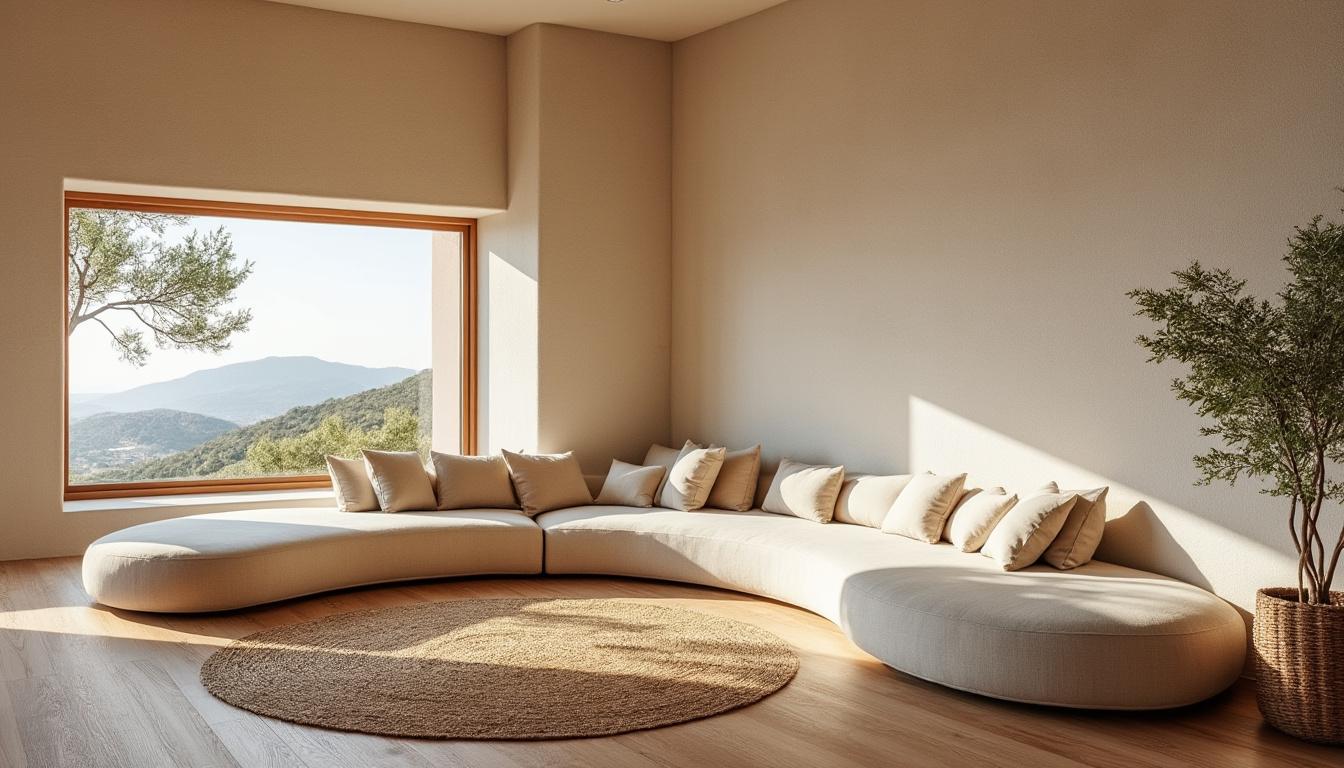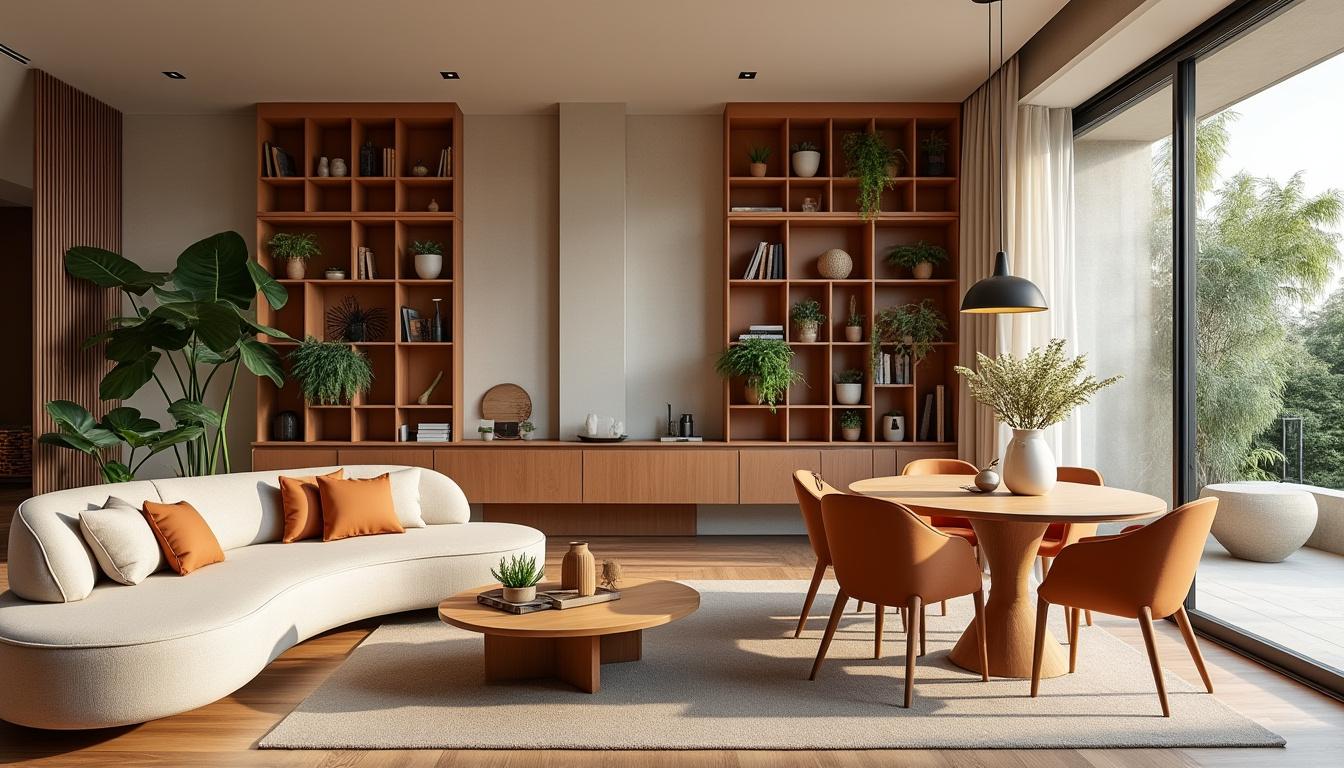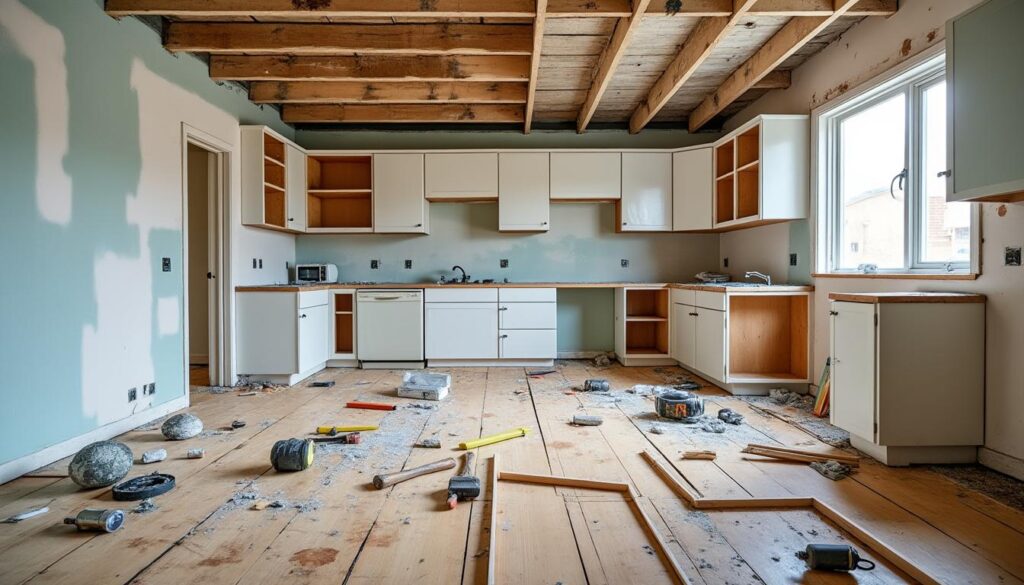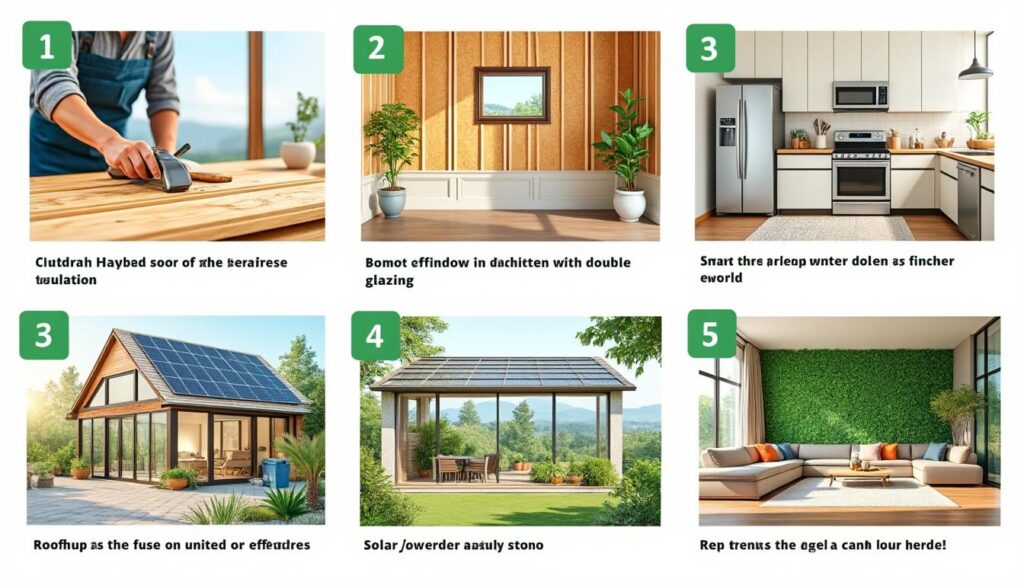Updating the home is an opportunity to gain comfort, efficiency, and beauty — without excess and with smart choices. This guide gathers trends and inspirations for a residential renovation aligned with sustainability and well-being.
| Short on time? Here’s the essentials: | Summary |
|---|---|
| ✅ Key Point #1 🌿 | Natural materials and earthy colors create cozy, elegant, and timeless environments without major renovations. |
| ✅ Key Point #2 💡 | Invisible technology (lighting automation, sensors, and built-in sound) enhances comfort and reduces consumption. |
| ✅ Key Point #3 ⚠️ | Avoid impulse purchases: plan the layout, measure the space, and define a palette before investing. |
| ✅ Key Point #4 🎨 | Value local art and crafts to add personality with a low environmental impact. |
Residential renovation with natural materials: warm minimalism and earthy colors
An effective update starts with the foundation: materials, colors, and textures. Natural minimalism is not monotony; it is the quest for the essential with warmth and authenticity. Investing in light woods, local stones, and organic fabrics reduces visual noise and enhances air quality and touch, while prioritizing durability.
The earthy palettes — clay, terracotta, beige, and olive green — create smooth transitions between spaces, work well with indirect lighting, and welcome both Japandi style and handcrafted pieces full of history. In kitchens, natural stone countertops with a matte finish and reclaimed wood handles deliver sobriety and strength. In living rooms, linen sofas and bouclé blankets provide texture and comfort without feeling “heavy”.
Practical steps to update surfaces
For those seeking quick results, painting a feature wall with sandy or terracotta tones changes the perception of depth. Burnt plaster finishes on bedheads add character at a moderate cost. The floor can receive natural fiber rugs (sisal, jute, organic cotton) to demarcate areas and improve acoustic comfort.
- 🎯 Define a palette of 3 base colors + 2 accents (e.g., sand, olive, ivory + terracotta and charcoal).
- 🌿 Prefer certified wood and water-based finishes (less odor and VOCs).
- 🧱 Combine textures: smooth (paint) + porous (stone) + soft (fabrics) for sensory balance.
- 🛠️ Replace shiny hardware with brushed rust or aged brass for an honest touch.
- 💸 Repurpose: sanding and natural oil revive old furniture with minimal investment.
Realistic example: a compact living room that breathes
In an urban T1, replacing a tall bookshelf with light wood shelves and invisible mounting opened up space and lateral light. A natural wool rug defined the living area and cushioned echoes. The wall behind the sofa, in light clay, softened the visual temperature, and the linen curtain filtered the light while maintaining privacy.
| Material/Finish | Main Benefit | Emissions/VOC | Usage Notes |
|---|---|---|---|
| Reclaimed wood 🌳 | Visual warmth and renewability | Low (with water-based sealant) | Great for furniture and panels |
| Burnt plaster 🧱 | Elegant artisanal texture | None after curing | Accent walls and bedheads |
| Organic linen 🧵 | Tactile comfort and breathability | Low | Sofas, curtains, cushions |
| Natural stone 🪨 | Durability and freshness | None | Kitchens, halls, and fireplaces |
Starting with the essentials — color, texture, and material — gives coherence to subsequent choices, even when moving on to plants and natural lighting in the next step.

Biophilic design and living walls: nature inside the home without complicating
Bringing nature indoors has measurable effects: improved mood, reduced stress, and more stable air quality. In residential renovation, biophilia acts as a “glue” between materials and colors, as well as softening hard lines of furniture. Modular vertical gardens, floor pots, and hanging arrangements create green layers that adapt to large areas or micro-spaces.
Before buying plants, map out light (direct, indirect, or low), ventilation, and humidity. Well-ventilated kitchens and bathrooms support species that appreciate humidity; living rooms and bedrooms require leaves that filter the air and demand little watering. In living walls, systems with reservoirs and lightweight substrates simplify maintenance and prevent leaks.
How to set up a functional vertical garden
The secret lies in the right module. Kits with capillary irrigation reduce watering frequency and prevent runoff. Define a structure with frontal access to the plants and plan for drainage. For a start, mix resilient species like pothos and zamioculca, alternating heights and leaf shapes for a dynamic effect.
- 🧭 Positioning: bright indirect light is the most versatile for living walls.
- 💧 Watering: prefer reservoir irrigation and simple moisture sensors.
- 🔧 Maintenance: light monthly pruning and leaf cleaning preserve photosynthesis.
- 🪴 Smart mix: 70% easy species + 30% highlights (ferns, calatheas).
- 🕯️ Atmosphere: complement with 3000K lighting to enhance green without “overheating” too much.
| Species | Light | Watering | Benefit |
|---|---|---|---|
| Pothos (Epipremnum) 🍃 | Medium indirect | Moderate | High tolerance, great for beginners |
| Zamioculca 🌿 | Low to medium | Low | Drought resistant, glossy foliage |
| Medium | High humidity | Visual volume and freshness | |
| Peperomia 🌱 | Indirect | Moderate | Varied foliage in small spaces |
Lighting that respects the circadian rhythm
If the house receives little light, full-spectrum fixtures or adjustable LEDs (color temperature and intensity) help maintain healthy plants and your visual well-being. On shelves, dimmable LED strips of 2700–3000K reinforce nighttime coziness. Avoid cold light in resting areas; reserve 4000–5000K for specific tasks.
- 🌞 Morning: 3500–4000K to activate without washing out earthy tones.
- 🌤️ Afternoon: 3000–3500K for comfortable reading.
- 🌙 Night: 2700K with dimmer; focus on indirect light and wall sconces.
Biophilia is not an excess of pots but a well-being strategy: a little green in the right spot changes the mood of the environment and values the natural materials presented earlier.
Curved and multifunctional furniture: visual comfort, fluidity, and well-utilized space
Curved lines are back to soften corners and guide circulation. Rounded sofas, oval tables, and embracing armchairs create visual comfort and reduce collisions in compact layouts. The organic shape works well with earthy palettes and textures like bouclé and linen, delivering contemporaneity without short-term trends.
At the same time, living well demands multifunctional furniture. Modular shelves that separate environments, foldable tables that turn into desks, storage ottomans, and beds with drawers expand utility without crowding the house. The Japandi style inspires the elimination of the superfluous with quality pieces, while maximalism, used with curation, leaves room for color and art without compromising order.
Layout planning in 5 steps
- 📏 Measure everything: comfortable minimum circulation is 80–90 cm between pieces.
- 🌀 Prefer curves in flows: oval tables “unclog” narrow rooms.
- 🧩 Modularity: think about modules that grow with the family.
- 🧺 Hidden storage: storage ottomans and benches with tops solve clutter.
- 🎯 Focus zone: each area with purpose (reading, working, socializing) and dedicated lighting.
Practical example: T2 with integrated living/dining room
In an integrated layout, a curved sofa defines the living area, while a light wood oval table brings chairs together without blocking the passage. An open shelf delineates the office with hanging plants, ensuring privacy without blocking light. A central dimmable pendant and side sconces create layers of lighting for dining, reading, or socializing.
| Environment | Key Piece | Extra Function | Why It Works |
|---|---|---|---|
| Living room 🛋️ | Curved sofa | Defines flow | Softens corners and guides circulation |
| Dinner 🍽️ | Oval table | Temporary office | Avoids edges, utilizes chairs |
| Bedroom 🛏️ | Bed with drawers | Linen storage | Storage without extra furniture |
| Entry 🚪 | Storage bench | Shoe storage | Practical and daily organization |
- 🖼️ Maximalism with method: limit to 3 patterns per environment and repeat colors for cohesion.
- 🧯 Safety: rounded corners reduce accidents in homes with children.
- ♻️ Sustainable: opt for repairable structures and removable/washable fabrics.
Curved and multifunctional pieces make the house look bigger and calmer; subsequently, integrating technology without “appearing” multiplies this feeling.

Invisible technology and efficiency: automation that doesn’t steal the spotlight
The right technology works silently for comfort. In residential renovation, discreet automation entails embedding solutions: scene dimming, presence sensors, motorized blinds, distributed audio, and efficient climate control. The goal is to reduce consumption, simplify routines, and maintain a clean aesthetic.
Start with what has the most impact: lighting and climate control. Dimmable LED bulbs with adjustable temperature save energy and adapt to the circadian rhythm. Sensors turn off lights in passage areas, while smart thermostats learn habits and avoid waste. In windows, solar control films and thermal curtains add comfort at affordable costs.
Infrastructure and privacy
If there is minor work, anticipate extra conduits for future expansions and central position routers. In audio, ceiling-mounted, paintable speakers deliver ambient music without visual clutter. For privacy, separate networks for guests and encryption of the automation system prevent unauthorized access.
- 🔌 Plan scenes: “Arrival,” “Reading,” “Night” — a single touch, the whole house responds.
- 🌡️ Smart thermostats + window sensors reduce energy spikes.
- 🪟 Low-e films and insulated curtains improve instant thermal comfort.
- 🔊 Built-in sound with limiter protects neighborhood and acoustic quality.
- 🔐 Separate network for IoT and unique passwords per device.
| Solution | Benefit | Complexity | Usage Tip |
|---|---|---|---|
| Dimmers and scenes 💡 | Comfort and savings | Low | 3000K at night, scenes by environment |
| Presence sensor 🚶 | Avoids lights left on | Low | Perfect for hallways and bathrooms |
| Smart thermostat 🌡️ | Optimized consumption | Medium | Geo-fencing for pre-heating |
| Built-in sound 🔊 | Clean aesthetics | Medium | Paintable boxes and zone control |
Small victories count: replacing 10 bulbs with dimmable LEDs, installing a thermostat, and programming scenes reduces the bill and improves your routine immediately.
Art, local crafts, and style fusion: personality with responsibility
Memorable environments have a story. Art — paintings, sculptures, ceramics — and local crafts add identity, support regional economies, and bring the home closer to its inhabitants. In 2025, the trend is to give prominence to author pieces, without excess. A unique mural on burnt plaster, a wool tapestry, or a bench carved from responsibly managed wood transform the atmosphere.
Balancing styles is also healthy. Mixing contemporary clean lines with family heirlooms creates good tension: a vintage dresser with updated handles, a modern sofa paired with a traditional rug. And when the desire is for color, vibrant accents (cobalt blue, emerald green, mustard yellow) work best in cushions, artwork, and items — easy to swap without waste.
Curated sense
Before buying, define the message: calm, energy, memory? Use the base palette as a guide and repeat at least one color in three points of the space for cohesion. Prefer limited editions and photography by local authors. On the wall, the two-thirds rule for heights and groupings with breathing space avoids “visual pollution.”
- 🖼️ Hang works center at 1.55 m from the floor: museum height for comfortable reading.
- 🧱 On textures: art with floating frames stands out on plaster and stone.
- 🎨 Bright colors in controlled doses: 20% accent, 80% base.
- 🧶 Make room for handmade: ceramics, basketry, and tapestries warm and reduce footprint.
- 🔁 Rotate pieces by season to keep freshness without buying more.
Case study: a living room that gained soul
In the Santos family home, two watercolors by a local artist were placed above the sideboard, aligned at 1.55 m. The frames in certified wood dialogued with the floor, and track lighting with dimmable spots created a discreet gallery. Cushions in emerald green repeated the tone of the works, while a basket of natural fibers organized blankets and magazines.
| Item | Investment | Impact | Sustainable Note |
|---|---|---|---|
| Author work 🖼️ | Medium | Visual focus and identity | Support local artists |
| Handcrafted rug 🧶 | Medium/High | Comfort and acoustics | Natural fibers and simple repair |
| Local ceramics 🏺 | Low | Texture and color | Low-impact production |
| Gallery lighting 💡 | Medium | Controlled highlight | Dimmable LED, low consumption |
- 📚 Final Tip: create a “memory map” with labels behind the works (author, date, story).
- 🧩 Style fusion works when there is material repetition (wood, metal, fabric) between pieces.
- 🌍 Prefer short logistics: less transport, more authenticity.
When the home tells its story with durable and responsible pieces, each environment gains presence without needing more objects — just better choices.
Simple action to start today: choose a room and make 1 high-impact change — paint a wall in an earthy tone OR replace 3 bulbs with dimmable LED. The rest will follow.
{“@context”:”https://schema.org”,”@type”:”FAQPage”,”mainEntity”:[{“@type”:”Question”,”name”:”What changes bring the greatest impact without renovations?”,”acceptedAnswer”:{“@type”:”Answer”,”text”:”Painting in an earthy tone, dimmable lighting, and natural textiles (curtains, rugs, cushion covers) transform the atmosphere in a few hours and with controlled costs. Combine with easy plants, such as pothos, to complete the effect.”}},{“@type”:”Question”,”name”:”How to choose between Japandi and maximalism?”,”acceptedAnswer”:{“@type”:”Answer”,”text”:”Define what you need: if you seek order and calm, opt for Japandi (fewer pieces, natural materials). If you want energy and expression, apply maximalism with curation (3 patterns, repeated colors, and good neutral bases). The two can coexist when there is palette cohesion and material repetition.”}},{“@type”:”Question”,”name”:”Is home automation expensive?”,”acceptedAnswer”:{“@type”:”Answer”,”text”:”Start small: dimmers, presence sensors, and smart thermostats already provide comfort and savings with low to medium investment. Plan extra conduits for future evolution (built-in sound, motorized blinds) without rework.”}},{“@type”:”Question”,”name”:”Which plants thrive well in apartments?”,”acceptedAnswer”:{“@type”:”Answer”,”text”:”Zamioculca, pothos, and peperomia tolerate indirect light and infrequent watering. In ventilated bathrooms, ferns do well. Use pots with reservoirs and check moisture before watering to avoid excess.”}},{“@type”:”Question”,”name”:”How to integrate art without weighing down the budget?”,”acceptedAnswer”:{“@type”:”Answer”,”text”:”Prefer limited edition prints, author photography, and local ceramics. Plan a linear gallery at 1.55 m height and light with LED spots. Rotate pieces by season to refresh without buying more.”}}]}What changes bring the greatest impact without renovations?
Painting in an earthy tone, dimmable lighting, and natural textiles (curtains, rugs, cushion covers) transform the atmosphere in a few hours and with controlled costs. Combine with easy plants, such as pothos, to complete the effect.
How to choose between Japandi and maximalism?
Define what you need: if you seek order and calm, opt for Japandi (fewer pieces, natural materials). If you want energy and expression, apply maximalism with curation (3 patterns, repeated colors, and good neutral bases). The two can coexist when there is palette cohesion and material repetition.
Is home automation expensive?
Start small: dimmers, presence sensors, and smart thermostats already provide comfort and savings with low to medium investment. Plan extra conduits for future evolution (built-in sound, motorized blinds) without rework.
Which plants thrive well in apartments?
Zamioculca, pothos, and peperomia tolerate indirect light and infrequent watering. In ventilated bathrooms, ferns do well. Use pots with reservoirs and check moisture before watering to avoid excess.
How to integrate art without weighing down the budget?
Prefer limited edition prints, author photography, and local ceramics. Plan a linear gallery at 1.55 m height and light with LED spots. Rotate pieces by season to refresh without buying more.


